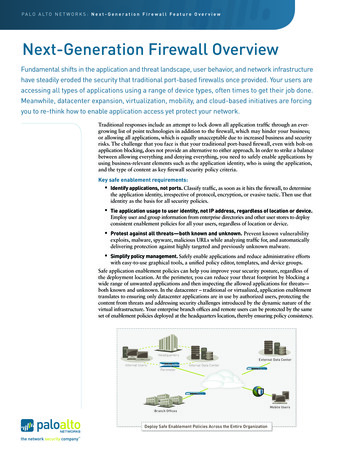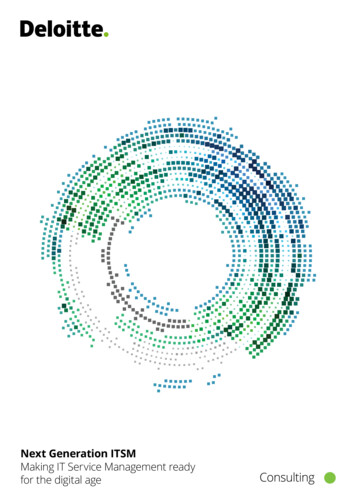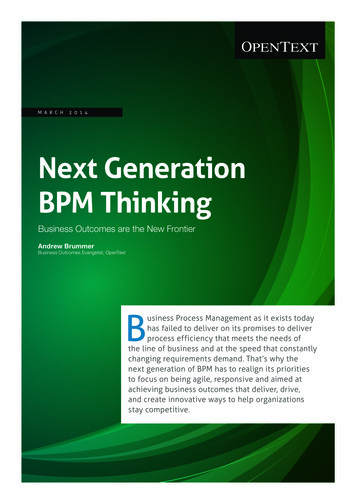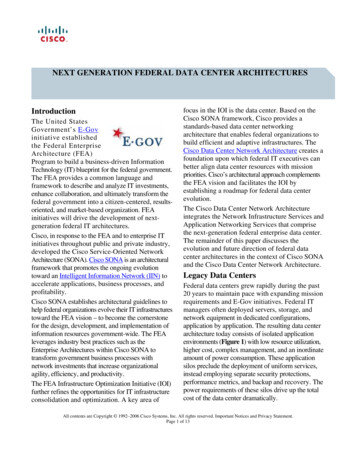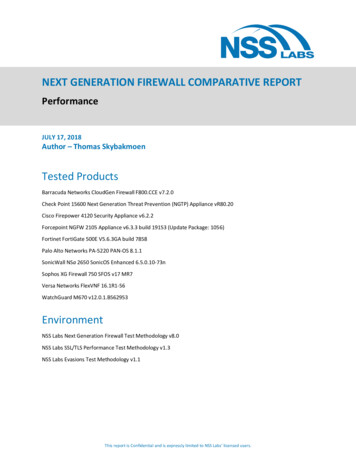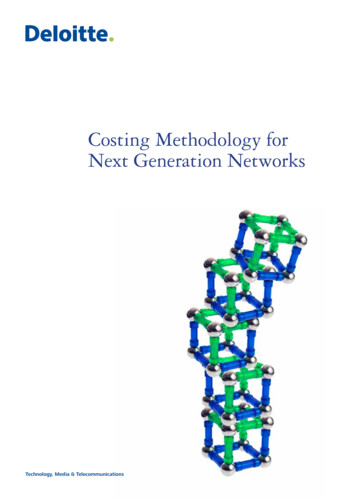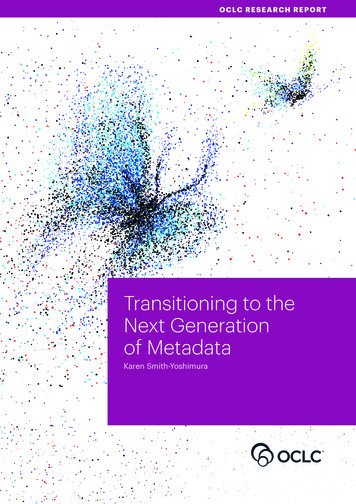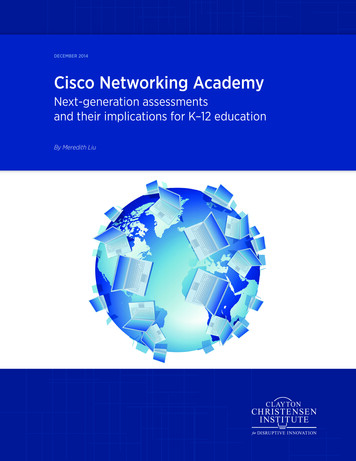
Transcription
August 2014December2014Cisco Networking AcademyNext-generation assessmentsand their implications for K–12 educationBy Meredith Liu
Cisco Networking AcademyNext-generation assessments and theirimplications for K–12 EducationTo illuminate the possibilities for next-generation assessments in K–12 schools, this case study profilesthe Cisco Networking Academy, which creates comprehensive online training curriculum to teachnetworking skills. Since 1997, the Cisco Networking Academy has served more than five million highschool and college students and now delivers approximately one million online assessments per monthin a variety of formats. Its advanced and highly integrated assessment system offers lessons for K–12technology and assessment.INTRODUCTIONIn 1996, Cisco Systems, Inc., an American multinational corporation headquartered in San Jose,Calif., that designs, manufactures, and sells networking equipment, discovered that althoughthe computer networking industry was booming, there was a shortage of qualified candidatesto design, build, manage, and secure computer networks. In response, the company integratedbackward and founded the Cisco Networking Academy (NetAcad), a comprehensive onlinetraining curriculum offered to third-party education institutions to help high school and collegestudents acquire the fundamental skills needed to design, build, and troubleshoot computernetworks. NetAcad employs a system of assessments to help drive consistent learning across itstraining sites around the world.NetAcad launched in October 1997 at 64 educational institutions in seven U.S. states. Sinceits launch, the program has expanded to more than 9,000 high schools, colleges, technicalschools, and community organizations in 50 U.S. states and 170 countries with its curriculumtaught in 16 languages. More than five million students have participated in NetAcad coursesand collectively taken 143.2 million online assessments.Cisco Systems credits its strong public-private partnership model for NetAcad’s rapid growth.From the outset, the company envisioned a distributed delivery structure in which it would reachmore students by partnering with existing educational institutions. As George Ward, formerCisco Systems engineer and founder of NetAcad, said, “Cisco [Systems] knows networking,teachers know education. By partnering, students win.” Cisco Systems provides NetAcad onlineCisco Networking Academy1
content, lab materials, and instructor training for free to institutional partners, which in turnprovide classroom space, computer lab equipment, and qualified instructors.1How NetAcad worksNetworking proficiency requires an array of hardware and software skills. The initial versionof NetAcad offered a four-course sequence that provided students with the practical systemsnetworking skills needed to obtain the Cisco Certified Network Associate (CCNA) Certification,a certification for entry-level networking jobs that an independent group separate from NetAcadadministers.2,3 Today, NetAcad’s instructional model combines face-to-face facilitation byinstructors; in-person, hands-on labs; and online learning. Cisco Systems provides participatingeducational institutions with a comprehensive package of instructional tools and curriculum,including hands-on lab materials; online practice activities; a simulation tool; a visualization andassessment engine called Cisco Packet Tracer; and educational games. The program also offersparticipating educational institutions discounted equipment bundles and a range of supportservices, including a global 24/7 NetAcad help desk.Cisco NetSpaceNetAcad delivers its online curriculum and assessments through a cloud-based learningmanagement system (LMS) called Cisco NetSpace. On Cisco NetSpace, students can navigatethrough online course material, complete assignments and assessments, and communicate withtheir instructors. The portal is available at all times so that students can complete activities attheir convenience.On the back end, instructors use Cisco NetSpace to manage their courses. The site alsoserves as a management system for NetAcad administrators and has the functionality to simplifycommon administrative tasks such as enrollment tracking, scheduling, and managing equipmentinventory.Because the system is cloud-based, it also supports the needs of curriculum and assessmentdevelopers at Cisco Systems. As developers change or create curriculum or assessment items, theycan distribute these materials quickly and cost effectively across NetAcad’s 9,000 sites, whichensures consistency across the academies.Cisco Systems designed the NetAcad curriculum and instructional model to ensure thatstudents develop a range of systems networking competencies, while accounting for differentteaching and learning styles across the academies worldwide. With students in 170 countries,NetAcad seeks to be both “globally consistent and locally relevant.”4 Even though the content andtools are standardized across sites, NetAcad recognizes the need for instructors to add context andadditional information appropriate to their local economies. As such, the NetAcad curriculum is2CLAYTON CHRISTENSEN INSTITUTE
designed to be instructor-facilitated—that is, instructors create classes in Cisco NetSpace, enrollstudents, and provide instruction. NetAcad designs tools for its instructors to manage each courseand assign the online content and activities that align with their in-person sessions. Instructorscan also use Cisco NetSpace tools to supplement the curriculum with activities and assessmentsthat they build themselves.ASSESSMENTSBesides its impressive scale and distributed model, what sets Cisco Systems’ network trainingcurriculum apart is its emphasis on online assessment tools. As Cisco Systems developedNetAcad, it sought to rethink what it viewed as the traditional, flawed assessment paradigm. Inmany educational settings, assessments are used solely for accountability, grading, or promotion.Instead, NetAcad designers wanted assessments to provide instructors with feedback on studentlearning that they could use to inform instruction in real-time and provide students with up-todate information on their progress and understanding of the material.NetAcad designers reframed the use of assessments as primarily for learning (formative)rather than evaluation (summative). Summative assessments allow instructors to evaluate studentlearning and award course credit; they remain critical to the goal of ensuring that NetAcad coursecompletion and the subsequent certification is meaningful beyond the walls of the classroom.Formative assessments, on the other hand, help students, instructors, and administrators collect,analyze, and use information about student learning progressions to continuously drive andimprove learning. To shift to primarily formative assessment, Cisco Systems built a broader anddeeper portfolio of assessments, designed new technologies to assess how students grapple withcontent in real-time, and honed a process for creating consistently high-quality assessments.Today, NetAcad delivers more than one million assessments to roughly one million studentseach month. The following sections describe the new methods of assessment that Cisco Systemspursued in its expanded assessment portfolio; the design principles and data-driven cycles ofimprovement that guided this process; and the costs associated with NetAcad.Assessment portfolioSince launching NetAcad, Cisco Systems has developed a wide range of assessments that are flexibleenough to meet the diverse needs of its students and instructors. Instructors have full discretionover how they use the assessments, including which assessments to deliver and whether to usea given assessment for formative or summative purposes depending on the needs of the course.Building an assessment portfolio was not a small task: computer-networking skills are fluid andCisco Networking Academy3
complex and thus can be challenging to assess. NetAcad students must not only learn the necessarycontent knowledge, but also the technical skills to design and construct physical networks, suchas the organization and layout of hardware and cables, as well as business and problem solvingskills that are more conceptual in nature. NetAcad’s assessments vary in complexity, length,and type. The assessments use constrained response (multiple choice, matching/drag and drop,fill-in-the-blank) to evaluate a learner’s content knowledge and skills; rubric-graded, in-personhands-on exams to assess manual skills; and simulation-based performance exams to evaluatemore advanced problem solving skills. Table 1 summarizes the current assessment portfolio.NetAcad’s formative assessments are primarily intended to gauge progress, not evaluateperformance. Much like quizzes in traditional courses, students take NetAcad quizzes that areembedded in the online curriculum after completing specific sections of content. Unlike quizzesin traditional courses, however, NetAcad created these quizzes for student self-assessment; theyTable 1. NetAcad’s assessment portfolio (Source: Cisco Networking Academy)AcademyAssessmentItem/Task TypeStudent- sFormative erformance*Topic, section, andchapter quizzesPacket Tracer labsTestletsPacket Tracer modelingand simulation activitiesInteractive media (e.g.,drag-and-drop, syntaxchecker, etc.)Skills integrationchallengeLearning checkpointsPacket Tracer-basedlearning checkpointsCourse chapter examsHands-on practiceCourse midtermcheckpointPacket Tracer-basedskills assessmentsPre-testsPacket Tracer multi-usergame skills checkCourse finalHands-on equipmentskills assessmentsPractice finalsAspire game skillscheckCertification practiceexams* Performance of networking skills is based on understanding.4Summative AssessmentsCLAYTON CHRISTENSEN INSTITUTETo triangulate what students know, astudent, their instructor, and NetAcadcan draw upon this Assessmenttoolkit.Moving towardubiquitous formativeassessment.Focus on knowledgeand skills acquisition.
are optional and not registered in an online grade book (although the instructor can changethe attributes of the quiz to meet her classroom needs). Additional learning activities—such asshort questions that check for understanding, modeling activities, reflections questions, and minisimulation exercises—are also interspersed throughout NetAcad’s online curriculum.On the back end, the NetAcad assessment system requires a large amount of processing powerand sophisticated infrastructure to operate smoothly. As students complete summative andformative assessments in educational institutions across the world, data is immediately collectedand then transferred back through the cloud. Students receive their scores within minutes. Thegrades also go directly to a database that instructors can access through the online grade book.NetAcad’s goal behind these short quizzes and activities is to make assessment as seamless aspossible by tracking student performance during the learning process rather than after the fact.Other assessments may be used as either formative or summative. For example, someinstructors use end-of-chapter tests as a formative exercise in the form of homework, whereasothers use them as part of summative student evaluation as part of a student’s final grade. At theend of a course, NetAcad final knowledge exams provide summative assessments on the entirecourse content. Both end-of-chapter tests and final knowledge exams are taken online and scoredautomatically. In addition, students are required to complete a hands-on final exam under theobservation of a supervisor.Performance assessments and simulationsAlthough online assessment has always been a cornerstone of NetAcad courses, the assessmentshave evolved significantly since the program’s inception. NetAcad’s initial model used a simple,fixed-response assessment system—single-answer, multiple-choice exams that tested contentknowledge at various points in the course including a final exam at the conclusion. These onlinetests were complemented with an in-person, hands-on skills exam. As described above, someassessments were used formatively and others provided end-of-course summative evaluations.As the program developed, however, Cisco Systems sought to go beyond fixed response items tocreate performance-based tasks that could be scored automatically. Although scoring complexsimulations can be challenging, these assessments present the potential for far more useful andextensive data.To assess and gather multiple forms of student data, Cisco Systems developed Cisco PacketTracer5, a network simulation program that allows students to experiment with network behaviorand ask “what if ” questions. Cisco Packet Tracer is locally installed software that connects withthe NetAcad cloud.6 The technology offers a sophisticated simulation environment that presentsa wide range of complex scenarios to students. In the Cisco Packet Tracer “micro world,” studentscan use numerous virtual devices to create and troubleshoot an infinite number of modelCisco Networking Academy5
Figure 1. Example of a Cisco Packet Tracer activitynetworks. Cisco Packet Tracerprovides a graphical interfacethat allows students to designand build networks using simpledrag-and-drop functions so thatstudents can visualize processesthat would otherwise be hiddenin physical systems.A Cisco Packet Tracer activitythat might be completed in afew hours* is shown in Figure1. Figure 2 shows the “answernetwork” tree, which illustratessome of the aspects of thenetwork model being assessed.Figure 2. Example of the “answer network” tree for a Cisco PacketTracer activityFor the network topology shownin Figure 1, there are over 2,000components that can be assessed.Instructors can use Cisco PacketTracerfordemonstrations,homework, and assessments.In 2010, Cisco Systemsintroduce
Besides its impressive scale and distributed model, what sets Cisco Systems’ network training curriculum apart is its emphasis on online assessment tools. As Cisco Systems developed NetAcad, it sought to rethink what it viewed as the traditional, flawed assessment paradigm. In many educational settings, assessments are used solely for accountability, grading, or promotion. Instead, NetAcad .




